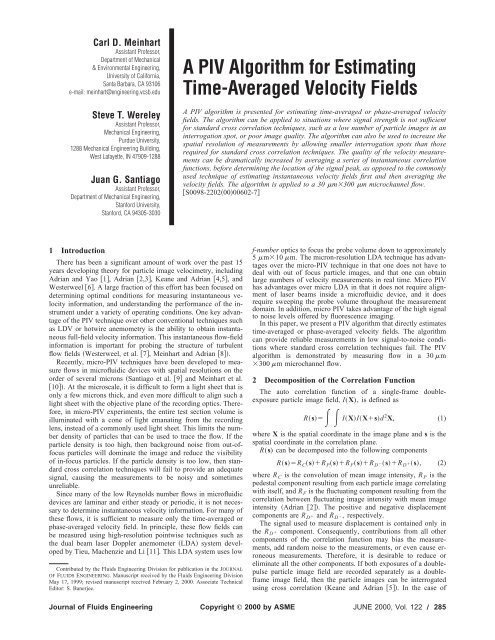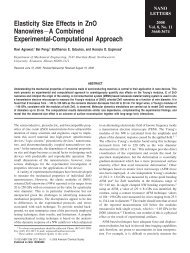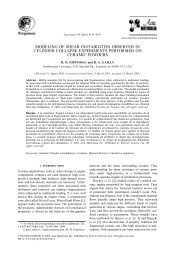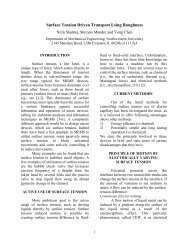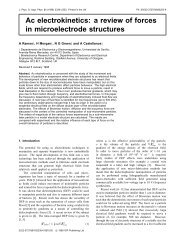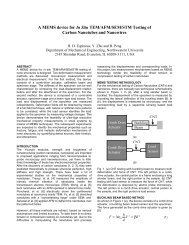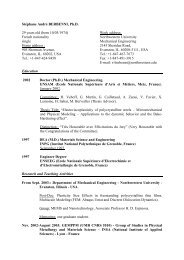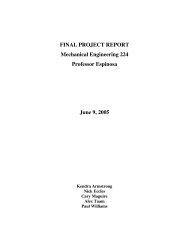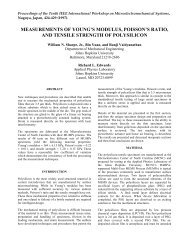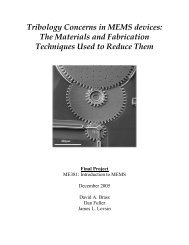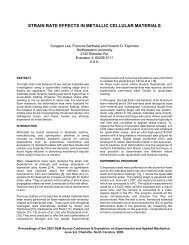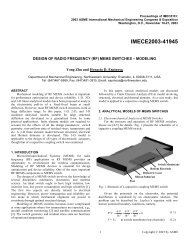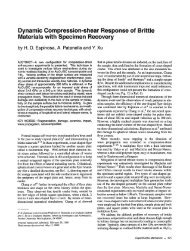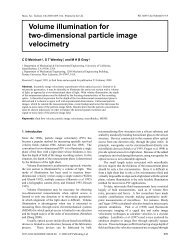A PIV Algorithm for Estimating Time-Averaged Velocity Fields
A PIV Algorithm for Estimating Time-Averaged Velocity Fields
A PIV Algorithm for Estimating Time-Averaged Velocity Fields
You also want an ePaper? Increase the reach of your titles
YUMPU automatically turns print PDFs into web optimized ePapers that Google loves.
Carl D. Meinhart<br />
Assistant Professor,<br />
Department of Mechanical<br />
& Environmental Engineering,<br />
University of Cali<strong>for</strong>nia,<br />
Santa Barbara, CA 93106<br />
e-mail: meinhart@engineering.vcsb.edu<br />
Steve T. Wereley<br />
Assistant Professor,<br />
Mechanical Engineering,<br />
Purdue University,<br />
1288 Mechanical Engineering Building,<br />
West Lafayette, IN 47909-1288<br />
Juan G. Santiago<br />
Assistant Professor,<br />
Department of Mechanical Engineering,<br />
Stan<strong>for</strong>d University,<br />
Stan<strong>for</strong>d, CA 94305-3030<br />
A <strong>PIV</strong> <strong>Algorithm</strong> <strong>for</strong> <strong>Estimating</strong><br />
<strong>Time</strong>-<strong>Averaged</strong> <strong>Velocity</strong> <strong>Fields</strong><br />
A <strong>PIV</strong> algorithm is presented <strong>for</strong> estimating time-averaged or phase-averaged velocity<br />
fields. The algorithm can be applied to situations where signal strength is not sufficient<br />
<strong>for</strong> standard cross correlation techniques, such as a low number of particle images in an<br />
interrogation spot, or poor image quality. The algorithm can also be used to increase the<br />
spatial resolution of measurements by allowing smaller interrogation spots than those<br />
required <strong>for</strong> standard cross correlation techniques. The quality of the velocity measurements<br />
can be dramatically increased by averaging a series of instantaneous correlation<br />
functions, be<strong>for</strong>e determining the location of the signal peak, as opposed to the commonly<br />
used technique of estimating instantaneous velocity fields first and then averaging the<br />
velocity fields. The algorithm is applied to a 30 m300 m microchannel flow.<br />
S0098-22020000602-7<br />
1 Introduction<br />
There has been a significant amount of work over the past 15<br />
years developing theory <strong>for</strong> particle image velocimetry, including<br />
Adrian and Yao 1, Adrian 2,3, Keane and Adrian 4,5, and<br />
Westerweel 6. A large fraction of this ef<strong>for</strong>t has been focused on<br />
determining optimal conditions <strong>for</strong> measuring instantaneous velocity<br />
in<strong>for</strong>mation, and understanding the per<strong>for</strong>mance of the instrument<br />
under a variety of operating conditions. One key advantage<br />
of the <strong>PIV</strong> technique over other conventional techniques such<br />
as LDV or hotwire anemometry is the ability to obtain instantaneous<br />
full-field velocity in<strong>for</strong>mation. This instantaneous flow-field<br />
in<strong>for</strong>mation is important <strong>for</strong> probing the structure of turbulent<br />
flow fields Westerweel, et al. 7, Meinhart and Adrian 8.<br />
Recently, micro-<strong>PIV</strong> techniques have been developed to measure<br />
flows in microfluidic devices with spatial resolutions on the<br />
order of several microns Santiago et al. 9 and Meinhart et al.<br />
10. At the microscale, it is difficult to <strong>for</strong>m a light sheet that is<br />
only a few microns thick, and even more difficult to align such a<br />
light sheet with the objective plane of the recording optics. There<strong>for</strong>e,<br />
in micro-<strong>PIV</strong> experiments, the entire test section volume is<br />
illuminated with a cone of light emanating from the recording<br />
lens, instead of a commonly used light sheet. This limits the number<br />
density of particles that can be used to trace the flow. If the<br />
particle density is too high, then background noise from out-offocus<br />
particles will dominate the image and reduce the visibility<br />
of in-focus particles. If the particle density is too low, then standard<br />
cross correlation techniques will fail to provide an adequate<br />
signal, causing the measurements to be noisy and sometimes<br />
unreliable.<br />
Since many of the low Reynolds number flows in microfluidic<br />
devices are laminar and either steady or periodic, it is not necessary<br />
to determine instantaneous velocity in<strong>for</strong>mation. For many of<br />
these flows, it is sufficient to measure only the time-averaged or<br />
phase-averaged velocity field. In principle, these flow fields can<br />
be measured using high-resolution pointwise techniques such as<br />
the dual beam laser Doppler anemometer LDA system developed<br />
by Tieu, Machenzie and Li 11. This LDA system uses low<br />
Contributed by the Fluids Engineering Division <strong>for</strong> publication in the JOURNAL<br />
OF FLUIDS ENGINEERING. Manuscript received by the Fluids Engineering Division<br />
May 17, 1999; revised manuscript received February 2, 2000. Associate Technical<br />
Editor: S. Banerjee.<br />
f-number optics to focus the probe volume down to approximately<br />
5 m10 m. The micron-resolution LDA technique has advantages<br />
over the micro-<strong>PIV</strong> technique in that one does not have to<br />
deal with out of focus particle images, and that one can obtain<br />
large numbers of velocity measurements in real time. Micro <strong>PIV</strong><br />
has advantages over micro LDA in that it does not require alignment<br />
of laser beams inside a microfluidic device, and it does<br />
require sweeping the probe volume throughout the measurement<br />
domain. In addition, micro <strong>PIV</strong> takes advantage of the high signal<br />
to noise levels offered by fluorescence imaging.<br />
In this paper, we present a <strong>PIV</strong> algorithm that directly estimates<br />
time-averaged or phase-averaged velocity fields. The algorithm<br />
can provide reliable measurements in low signal-to-noise conditions<br />
where standard cross correlation techniques fail. The <strong>PIV</strong><br />
algorithm is demonstrated by measuring flow in a 30 m<br />
300 m microchannel flow.<br />
2 Decomposition of the Correlation Function<br />
The auto correlation function of a single-frame doubleexposure<br />
particle image field, I(X), is defined as<br />
RsIXIXsd 2 X, (1)<br />
where X is the spatial coordinate in the image plane and s is the<br />
spatial coordinate in the correlation plane.<br />
R(s) can be decomposed into the following components<br />
RsR C sR P sR F sR D sR D s, (2)<br />
where R C is the convolution of mean image intensity, R P is the<br />
pedestal component resulting from each particle image correlating<br />
with itself, and R F is the fluctuating component resulting from the<br />
correlation between fluctuating image intensity with mean image<br />
intensity Adrian 2. The positive and negative displacement<br />
components are R D and R D , respectively.<br />
The signal used to measure displacement is contained only in<br />
the R D component. Consequently, contributions from all other<br />
components of the correlation function may bias the measurements,<br />
add random noise to the measurements, or even cause erroneous<br />
measurements. There<strong>for</strong>e, it is desirable to reduce or<br />
eliminate all the other components. If both exposures of a doublepulse<br />
particle image field are recorded separately as a doubleframe<br />
image field, then the particle images can be interrogated<br />
using cross correlation Keane and Adrian 5. In the case of<br />
Journal of Fluids Engineering Copyright © 2000 by ASME<br />
JUNE 2000, Vol. 122 Õ 285
double-frame cross correlation, the R P and R D components do<br />
not exist. Further improvements in signal quality can be obtained<br />
by image processing. By subtracting the mean image intensity at<br />
each interrogation spot be<strong>for</strong>e correlation, the R C and R F (s) components<br />
are set identically to zero, leaving only the positive displacement<br />
component, R D , in the correlation function.<br />
While the R D component is commonly considered the signal<br />
component, it contains both noise and signal in<strong>for</strong>mation. In order<br />
to make accurate measurements, the signal-to-noise ratio in the<br />
R D component must be sufficiently high. This paper presents a<br />
method in which the signal-to-noise ratio can be increased when<br />
one is interested in measuring average displacement fields.<br />
3 Methods of <strong>Estimating</strong> Average <strong>Velocity</strong> <strong>Fields</strong><br />
Average velocity fields can be obtained by first measuring instantaneous<br />
velocities and then averaging them in either space or<br />
time. Here we present an alternative method <strong>for</strong> measuring average<br />
velocity fields directly from the correlation function.<br />
Estimation of velocity-vector fields using <strong>PIV</strong> involves three<br />
primary steps:<br />
1 Particle Image Acquisition<br />
2 Particle Image Correlation<br />
3 Correlation Peak Detection<br />
In order to obtain an average velocity measurement, one must<br />
apply an averaging operation. The averaging operator is a linear<br />
operator, and can be applied after step 1, step 2, or step 3, to<br />
produce a nonbiased estimate of average velocity. The particleimage<br />
correlation and peak detection operations are both nonlinear,<br />
and the order in which the averaging operator is applied can<br />
dramatically change the quality of the resulting signal.<br />
In this section, we examine the three different methods <strong>for</strong> calculating<br />
average velocities based upon the order in which the<br />
averaging operator is applied. Here we assume that two single<br />
exposure images, Image A and Image B, are separated by a known<br />
time delay, t, and represent the image acquisition of a single<br />
realization. Furthermore, a sequence of two image pairs is acquired<br />
at N different realizations of a statistically stationary process.<br />
We wish to average over the N realizations to estimate the<br />
average velocity.<br />
3.1 Average <strong>Velocity</strong> Method. In this method, the estimate<br />
of the average velocity is determined by 1 correlating Image A<br />
and Image B, 2 detecting the peak from the instantaneous correlation<br />
functions, and 3 averaging over the instantaneous velocity<br />
measurements. Figure 1a graphically depicts this process.<br />
The primary advantage of this method is that one can obtain instantaneous<br />
velocity measurements, which may be of physical importance.<br />
However, if one is primarily interested in the average<br />
velocity field, this method may not be optimal.<br />
The nonlinear operation of peak detection is susceptible to producing<br />
erroneous measurements when the signal to noise is low in<br />
the instantaneous correlation. In practice, the vector fields must be<br />
validated by identifying and removing erroneous velocity measurements<br />
Meinhart et al. 12, Westerweel 13. Without vector<br />
validation, all the instantaneous measurements must be reliable in<br />
order to obtain a reliable average velocity measurement. For situations<br />
where the particle image density is low, there may not be<br />
adequate signal to obtain valid measurements from the instantaneous<br />
correlation functions. In these situations, the alternative<br />
methods described below may be employed.<br />
3.2 Average Image Method. In this method, the averaging<br />
operation is applied directly on image fields A and B, and then<br />
correlated to obtain R AB . This process is depicted graphically in<br />
Fig. 1b. In the situation where particle image number density is<br />
low, averaging the image fields together can increase the average<br />
number of particles per interrogation spot. However, excessive<br />
Fig. 1 Diagrams depicting the different ways in which the average<br />
velocity can be estimated: „a… average velocity method,<br />
„b… average image method, „c… average correlation method<br />
averaging of the image fields can create too many particle images<br />
in the interrogation spot and reduce the visibility of individual<br />
particle images.<br />
The 2-D spatial correlation function of the average of A and B<br />
image fields is defined as<br />
R AB sĀXB¯Xsd 2 X, (3)<br />
where Ā1/N N<br />
i1 A i is the average operator, averaging over N<br />
realizations of the flow field. Expanding the integrand of 3<br />
yields<br />
R AB s<br />
A 1 B 1 A 1 B 2 A 1 B 3 ¯A 1 B N <br />
A 2 B 1 A 2 B 2 A 2 B 3 ¯A 2 B N <br />
A 3 B 1 A 3 B 2 A 3 B 3 ¯A 3 B N <br />
" " " d 2 X.<br />
" " "<br />
" " "<br />
A N B 1 A N B 2 A N B 3 ¯A N B N<br />
Following the discussion in the previous section, if A and B<br />
represent paired single-exposure image fields separated by a<br />
known time interval, t, which are cross correlated, and if the<br />
mean image intensity is subtracted be<strong>for</strong>e correlation, then all N<br />
N terms in 4 are contained in the R D component of R.<br />
Only the N diagonal terms in 4 contribute to signal. The<br />
N(N1) off diagonal terms represent random particle correlation<br />
(4)<br />
286 Õ Vol. 122, JUNE 2000 Transactions of the ASME
across different realizations, which produce noise in the correlation<br />
function that can reduce the accuracy of the measurement and<br />
cause erroneous measurements. Since the off diagonal terms are<br />
random and uni<strong>for</strong>mly distributed throughout the correlation<br />
plane, they may or may not contaminate the signal peak. The<br />
number of noise terms increases as N 2 , while the number of signal<br />
terms increases as N.<br />
In demanding situations when particle-number density is low,<br />
or when small interrogation regions are chosen to produce high<br />
spatial resolution, it may be impossible to obtain an adequate<br />
signal from instantaneous cross correlation analysis. Clearly, averaging<br />
the particle-image fields over several realizations and then<br />
correlating can increase the signal-to-noise ratio. However, if the<br />
number of realizations used in the average is beyond an optimal<br />
number, the signal-to-noise ratio can be reduced by further increases<br />
in N. Loss of signal occurs because the number of nondiagonal<br />
noise terms increases faster than the diagonal signal<br />
terms. The optimal number of realizations depends upon many<br />
factors including, interrogation spot size, particle-image number<br />
density, and particle-image quality.<br />
3.3 Average Correlation Method. A third method <strong>for</strong> estimating<br />
average displacement fields is to calculate instantaneous<br />
correlation functions, average the correlation function, and then<br />
determine the location of the signal peak location. The Average<br />
Correlation Method, is shown graphically in Fig. 1c. The average<br />
of instantaneous correlation functions over N realizations can<br />
be written as<br />
R¯AB sAXBXsd 2 XAXBXsd 2 X.<br />
(5)<br />
Figure 2 shows several instantaneous correlation functions, and<br />
an average correlation function calculated by averaging 20 instantaneous<br />
correlation functions. The instantaneous correlation functions<br />
are characteristic of micro-<strong>PIV</strong> data and were obtained from<br />
an actual micro-<strong>PIV</strong> experiment. The instantaneous correlation<br />
functions contain significant amounts of noise that can lead to<br />
inaccurate or unreliable measurements. This noise is substantially<br />
less in the average correlation function.<br />
Since the operations of averaging and integration commute, the<br />
average operator can be taken inside of the integral so that<br />
R¯AB sA 1 B 1 A 2 B 2 A 3 B 3 ¯A N B N d 2 X. (6)<br />
Fig. 2 Instantaneous cross correlation functions that are averaged<br />
together to produce an average correlation function.<br />
The average correlation function has a much higher signal-tonoise<br />
ratio than the instantaneous correlation functions.<br />
From 6, the average correlation function contains only the<br />
diagonal i.e., signal terms of 4. There<strong>for</strong>e, this type of average<br />
produces a much higher signal-to-noise ratio than the alternative<br />
methods that have been discussed previously. The number of signal<br />
terms increases linearly with the number of realizations, N.<br />
Unlike the average image method, there is no penalty <strong>for</strong> including<br />
large numbers of realizations in the average. Since the average<br />
operator is applied to the correlation function be<strong>for</strong>e peak detection,<br />
the probability of erroneous measurements is greatly<br />
reduced.<br />
4 Application to Microchannel Flow<br />
The three different averaging algorithms were applied to a series<br />
of particle image fields taken of steady Stokes’ water flow<br />
through a 30 m300 m glass microchannel. Details of the<br />
same experiment but <strong>for</strong> a different flow rate are discussed by<br />
Meinhart et al. 10. The out of plane measurement resolution is<br />
related to the depth of field of the microscope optics, and is estimated<br />
to be approximately 1.8 m. Based on the discussion of<br />
Santiago et al. 9, the error due to Brownian motion <strong>for</strong> a single<br />
particle is estimated to be less than 3 percent full-scale error. The<br />
interrogation spot size was 1664 pixels and 2472 pixels, <strong>for</strong><br />
window 1 and window 2, respectively. The relative offset between<br />
the windows was adjusted adaptively to approximate the particle<br />
image displacement at each measurement location. The interrogation<br />
windows were chosen to be small and have a high aspect ratio<br />
to achieve high spatial resolution in the wall-normal direction.<br />
The signal-to-noise ratio from standard correlation techniques<br />
was relatively low, because there was an average of only 2.5<br />
particle images located in each 1664 pixel interrogation window.<br />
The signal-to-noise ratio could be improved by increasing<br />
the size of the correlation windows, but with reduced spatial resolution.<br />
Alternatively, the particle concentration in the flow field<br />
could be increased, but that would increase the number of out of<br />
focus particles, and produce more background image noise.<br />
Figure 3a shows an instantaneous velocity-vector field, calculated<br />
using a standard cross correlation technique without any<br />
type of vector validation or smoothing applied to the field. The<br />
velocity measurements contained in the row closest to the wall are<br />
not considered to be accurate, because part of their interrogation<br />
region lies outside the flow domain. The velocity measurements<br />
are noisy, and approximately 20 percent appear to be erroneous.<br />
An average over 20 instantaneous velocity fields is shown in Fig.<br />
3b. Averaging reduces small random noise in the instantaneous<br />
fields. However, the large errors associated with the erroneous<br />
measurements are not averaged out quickly. The application of<br />
vector validation algorithms can usually eliminate errors due to<br />
erroneous measurements producing accurate velocity measurements,<br />
however a priori knowledge of the flow field is required.<br />
The same series of double-frame particle image fields were correlated,<br />
the correlation functions were averaged, and then the locations<br />
of the signal peaks in the correlation plane were determined,<br />
following the average correlation method depicted in Fig.<br />
1c. The resulting velocity-vector field is shown in Fig. 3c. No<br />
vector validation or smoothing has been applied to this field. The<br />
field contains only 0.5–1 percent erroneous measurements and has<br />
less noise than the vector fields shown in Figs. 3a and 3b.<br />
The relative per<strong>for</strong>mance of the three averaging algorithms was<br />
quantitatively compared by varying the number of realizations<br />
used in the average, from one to twenty. The fraction of valid<br />
measurements <strong>for</strong> each average was determined by identifying the<br />
number of velocity measurements in which the streamwise component<br />
of velocity deviated by more than 10 percent from the<br />
known solution at each point. For this comparison, the known<br />
solution was the velocity vector field estimated by applying the<br />
average correlation technique to 20 realizations, and then smoothing<br />
the flow field.<br />
Figure 4 shows the fraction of valid measurements <strong>for</strong> each of<br />
the three algorithms as a function of the number of realizations<br />
used in the average. The average correlation method better than<br />
per<strong>for</strong>ms the other two methods, and produces less than 0.5–1<br />
percent erroneous measurements after averaging eight realizations.<br />
The average image method produces about 95 percent reliable<br />
velocity measurements, and reaches a maximum at four averages.<br />
Further increases in the number of realizations used to<br />
Journal of Fluids Engineering JUNE 2000, Vol. 122 Õ 287
Fig. 4 Comparison of the per<strong>for</strong>mance of the three averaging<br />
techniques: average velocity , average image , and average<br />
correlation <br />
Conclusions<br />
Three <strong>PIV</strong> algorithms are compared <strong>for</strong> estimated timeaveraged<br />
velocity fields. The process of obtaining <strong>PIV</strong> measurements<br />
involves three primary steps: 1 particle image acquisition,<br />
2 particle image correlation, and 3 correlation peak detection.<br />
In order to obtain average velocity fields, an averaging operator<br />
must be applied to the data. When signal strength is sufficient, the<br />
average can be applied after steps 1, 2, or 3. However, in demanding<br />
situations when signal strength is weak, the order in which the<br />
average operator is applied is important. The correlation and peak<br />
detection operators are nonlinear and do not commute with the<br />
average operator. Optimal signal strength can be achieved by first<br />
calculating instantaneous correlation functions, and then averaging<br />
the correlation functions be<strong>for</strong>e locating the signal peak.<br />
The theoretical observations were confirmed by applying the<br />
three different algorithms to experimental particle image data<br />
from a 30 m300 m microchannel flow. The results showed<br />
that, by averaging instantaneous correlation functions be<strong>for</strong>e signal<br />
peak detection, high quality velocity data can be obtained with<br />
less than 0.5–1 percent erroneous measurements, even when only<br />
an average of 2.5 particle images were contained in a single interrogation<br />
spot.<br />
Acknowledgments<br />
This research is supported by AFOSR/DARPA F49620-97-1-<br />
0515, DARPA F33615-98-1-2853, and JPL/NASA 961270.<br />
Fig. 3 <strong>Velocity</strong> vector fields showing the results from the different<br />
methods of calculation: „a… instantaneous velocity field,<br />
„b… time average of twenty instantaneous velocity fields, „c… velocity<br />
field calculated from time-averaged correlation functions<br />
average the images decreases the signal to noise of the average<br />
particle-image field, and produces noise in the correlation plane<br />
due to random correlation between nonpaired particle images. The<br />
average velocity method reaches a maximum of 88 percent reliable<br />
measurements using two velocity averages. Further increases<br />
in the number of averages decreases the number of reliable measurements,<br />
due to an increase in the probability of an encountering<br />
an erroneous measurement.<br />
References<br />
1 Adrian, R. J., and Yao, C. S., 1985, ‘‘Pulsed laser technique application to<br />
liquid and gaseous flows and the scattering power of seed materials,’’ Appl.<br />
Opt., 24, No. 1, pp. 44–52.<br />
2 Adrian, R. J., 1988, ‘‘Double Exposure, Multiple-field particle image velocimetry<br />
<strong>for</strong> turbulent probability density,’’ Opt. Lasers Eng., 9, pp. 211–228.<br />
3 Adrian, R. J., 1991, ‘‘Particle-imaging techniques <strong>for</strong> experimental fluid mechanics,’’<br />
Annu. Rev. Fluid Mech., 23, pp. 261–304.<br />
4 Keane, R. D., and Adrian, R. J., 1991, ‘‘Optimization of particle image velocimeters.<br />
II. Multiple pulsed systems,’’ Meas. Sci. Technol., 2, No. 10, Oct.,<br />
pp. 963–974.<br />
5 Keane, R. D., and Adrian, R. J., 1992, ‘‘Theory of cross-correlation analysis of<br />
<strong>PIV</strong> images,’’ Appl. Sci. Res., 49, pp. 191–215.<br />
6 Westerweel, J., 1997, ‘‘Fundamentals of digital particle image velocimetry,’’<br />
Meas. Sci. Technol., 8, pp. 1379–1392.<br />
7 Westerweel, J., Draad, A. A., van der Hoeven, J. G. Th., and van Oord, J.,<br />
1996, ‘‘Measurement of fully developed turbulent pipe flow with digital <strong>PIV</strong>,’’<br />
Exp. Fluids, 20, pp. 165–177.<br />
8 Meinhart, C. D., and Adrian, R. J., 1995, ‘‘On the existence of uni<strong>for</strong>m momentum<br />
zones in a turbulent boundary layer,’’ Phys. Fluids, 7, No. 4, pp.<br />
694–696.<br />
9 Santiago, J. G., Wereley, S. T., Meinhart, C. D., Beebe, D. J., and Adrian, R.<br />
288 Õ Vol. 122, JUNE 2000 Transactions of the ASME
J., 1998, ‘‘A micro particle image velocimetry system,’’ Exp. Fluids, 25, No.<br />
4, pp. 316–319.<br />
10 Meinhart, C. D., Wereley, S. T., and Santiago, J. G., ‘‘<strong>PIV</strong> measurements of a<br />
microchannel flow,’’ Exp. Fluids, 27, pp. 414–419.<br />
11 Tieu, A. K., Mackenzie, M. R., and Li, E. B., 1995, ‘‘Measurements in microscopic<br />
flow with a solid-state LDA,’’ Exp. Fluids, 19, pp. 293–294.<br />
12 Meinhart, C. D., Barnhart, D. H., and Adrian, R. J., 1994, ‘‘Interrogation and<br />
validation of three-dimensional vector fields,’’ Developments in Laser Techniques<br />
and Applications to Fluid Mechanics, R. J. Adrian et al., eds.,<br />
Springer-Verlag, Berlin, pp. 379–391.<br />
13 Westerweel, J., 1993, ‘‘Efficient detection of spurious vectors in particle image<br />
velocimetry data,’’ Exp. Fluids, 16, pp. 236–247.<br />
Journal of Fluids Engineering JUNE 2000, Vol. 122 Õ 289


